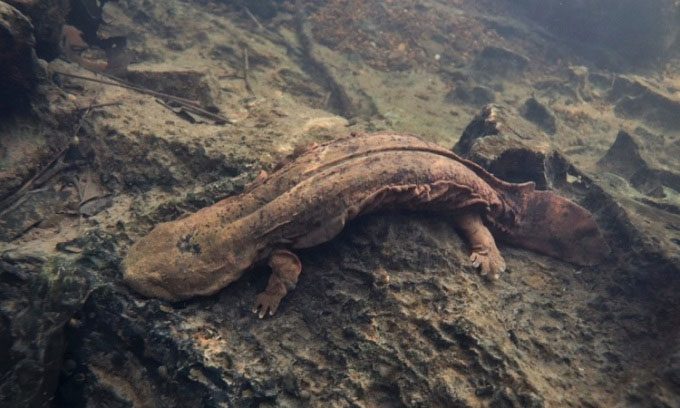The carnivorous habits of the hellbender salamander could lead them to the brink of extinction, according to research from Virginia Tech.
An eight-year study of hellbender salamanders living in cold, rocky rivers in southwestern Virginia found that male salamanders are increasingly consuming juveniles in areas near devastated forests. The lack of tree cover allows pollutants to flow into the rivers, altering the chemical composition of the water and affecting parental behavior. This cannibalistic behavior has spread to eastern hellbenders, the largest salamander species in North America, which can grow up to 60 cm long and weigh 2.3 kg, potentially wiping out future generations.

Adult hellbender salamander measures about 60 cm. (Photo: Jordy Groffen)
“If the rate of cannibalism continues to be this high, it is enough to explain the decline we are witnessing in this species,” said Bill Hopkins, an ecologist at Virginia Tech and the lead researcher. His findings will be published in the next issue of The American Naturalist, Yahoo reported on April 20.
The eastern hellbender once thrived in 15 states, from Mississippi and Missouri in the south to New York and Pennsylvania in the northeast. However, their numbers have dwindled over the past 50 years, and researchers are struggling to understand why. Habitat loss, disease, poaching, and climate change may all contribute to the situation. But according to Hopkins’ research, the driving factor may be the cannibalistic behavior as a response to deforestation. This behavior is relatively common in the animal kingdom.
During the fall breeding season, female hellbenders lay eggs and leave. The males fertilize the eggs and stay nearby for months to prevent predation and protect the healthy eggs until they hatch. However, when faced with difficult circumstances, male salamanders are willing to consume juveniles with a low survival rate. Such sacrifices help the salamanders conserve energy during food shortages, increasing their chances of surviving long enough to produce more healthy offspring in the future.
Biologists studying hellbender behavior had previously observed this form of cannibalism. However, Hopkins’ research indicates that this behavior is on the rise due to environmental damage caused by human activities like deforestation for cattle grazing. Hopkins and his colleagues set up hundreds of underwater nesting boxes in three rivers along the Tennessee River basin in southwestern Virginia. From 2013 to 2020, they monitored each box, tracking any nests they found.
The research team discovered that in areas with lush forests, male salamanders consumed entire clutches of young at a rate of 14%. However, this rate tripled when nearby trees were cut down. Hellbender salamanders seem to have fallen into a “evolutionary trap,” according to biologist Hope Klug at the University of Tennessee at Chattanooga. “They exhibit adaptive behavior. But this behavior is no longer adaptive due to rapid climate change,” Klug stated.
Hopkins’ team also collected blood samples from hellbender salamanders and examined changes in stress and reproductive hormones at deforested sites. Body condition, clutch size, or food availability appeared to be insignificant. Hopkins suspects that changes in water chemistry could be driving the behavior. He has now installed several sensors to monitor river conditions to test this hypothesis. Hopkins also plans to collect vulnerable eggs, raise them in the lab, and release the larvae once they reach an age where they are no longer prey for male salamanders.





















































